Fertile Crescent › Hellenic World » Ancient origins
Articles and Definitions › Contents
- Fertile Crescent › Antique Origins
- Hellenic World › Ancient History
Ancient civilizations › Historical and archaeological sites
Fertile Crescent › Antique Origins
Definition and Origins
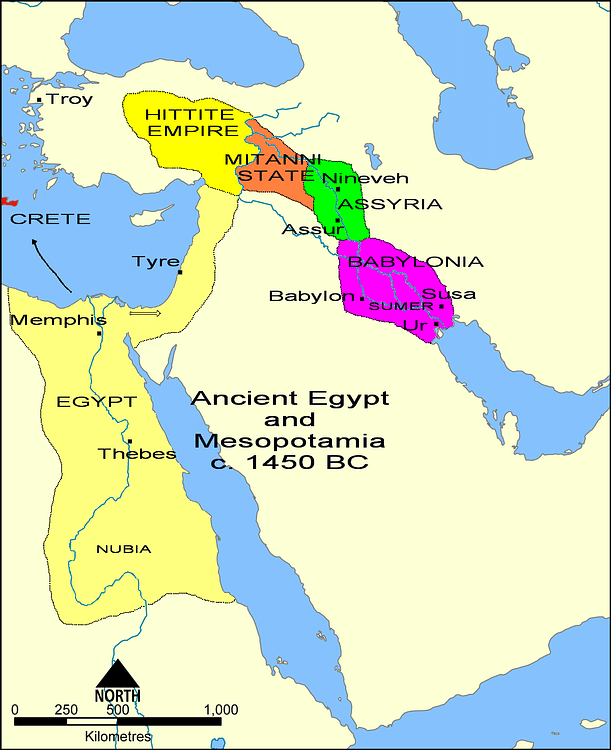
The Fertile Crescent, often called the "Cradle of Civilization ", is the region in the Middle East which curves, like a quarter-moon shape, from the Persian Gulf, through modern-day southern Iraq, Syria, Lebanon, Jordan, Israel and northern Egypt.The region has long been recognized for its vital contributions to world culture stemming from the civilizations of ancient Mesopotamia, Egypt, and the Levant which included the Sumerians, Babylonians, Assyrians, Egyptians, and Phoenicians, all of whom were responsible for the development of civilization.
Virtually every area of human knowledge was advanced by these people, including:
- Science and Technology
- Writing and Literature
- Religion
- Agricultural Techniques
- Mathematics and Astronomy
- Astrology and the Development of the Zodiac
- Domestication of Animals
- Long-Distance Trade
- Medical Practices (including dentistry)
- The Wheel
- The Concept of Time
The term was first coined in 1916 CE by the Egyptologist James Henry Breasted in his work Ancient Times: A History of the Early World, where he wrote:
This fertile crescent is approximately a semi-circle, with the open side toward the south, having the west end at the south-east corner of the Mediterranean, the centre directly north of Arabia, and the east end at the north end of the Persian Gulf. (193-194)
His phrase was widely circulated through the publications of the day becoming, finally, the common designation for this region.The Fertile Crescent is traditionally associated in the Jewish, Christian and Muslim faiths with the earthly location of the Garden of Eden. The area features prominently in the Bible and Quran and a number of sites there are associated with narratives from those works.
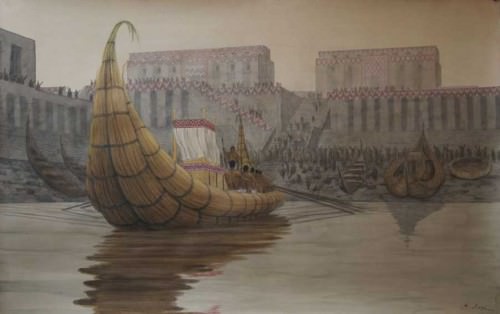
Representation of the Port of Eridu
CRADLE OF CIVILIZATION
Known as the Cradle of Civilization, the Fertile Crescent is regarded as the birthplace of agriculture, urbanization, writing, trade, science, history and organized religion and was first populated c. 10,000 BCE when agriculture and the domestication of animals began in the region. By 9,000 BCE the cultivation of wild grains and cereals was wide-spread and, by 5000 BCE, irrigation of agricultural crops was fully developed. By 4500 BCE the cultivation of wool-bearing sheep was practiced widely.
THE GEOGRAPHY & CLIMATE OF THE REGION WERE CONDUCIVE TO AGRICULTURE & HUNTER-GATHERER SOCIETIES SHIFTED TO SEDENTARY COMMUNITIES.
The geography and climate of the region were conducive to agriculture and hunter-gatherer societies shifted to sedentary communities in the area as they were able to support themselves from the land. The climate was semi-arid but the humidity, and proximity of the Tigris and Euphrates Rivers (and, further south, the Nile ), encouraged the cultivation of crops. Rural communities developed along with technological advances in agriculture and, once these were established, domestication of animals followed.
The first cities began to rise in Mesopotamia in the region of Sumer. Eridu, the first, according to the Sumerians, in 5400 BCE, then Uruk and others. By c. 4500 BCE cultivation of wheat and grains had long been practiced in addition to the further domestication of animals. By the year 3500 BCE the image of the breed of dog known as the Saluki was appearing regularly on vases and other ceramics as well as wall paintings along with breeds such as the Dane, Greyhound, and Mastiff.
The unusually fertile soil of the region encouraged the further cultivation of wheat as well as rye, barley, and legumes and some of the earliest beer in the world was brewed in the great cities along the Tigris and Euphrates Rivers under the auspices of the goddess Ninkasi. Beer was considered a gift from the gods and a source of daily nutrition as well as an intoxicant. It was used to pay people's wages but inscriptions also make clear it was brewed for celebratory purposes and the famous Hymn to Ninkasi praises the brew for making one's heart feel light.
This beer was quite different from that of the modern day as it was thick and had to be consumed with a straw to filter out residue from the fermenting process. Beer brewing probably evolved from the baker's craft as the barley and wheat they stored fermented. The most ancient evidence of beer brewing comes from the Sumerian outpost settlement of Godin Tepe in modern-day Iran.
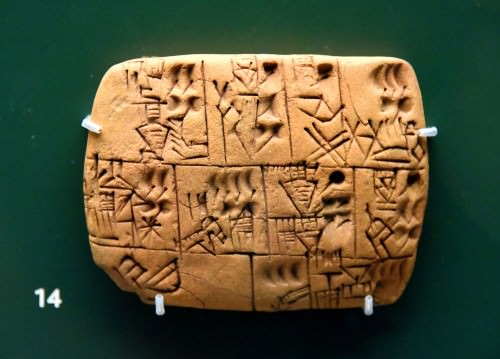
Mesopotamian Beer Rations Tablet
Emmer wheat, barley, chickpeas, lentils, and many other crops were planted, harvested, and sent to the temples where food supplies were stored. From c. 3400 BCE, the priests of the temple complexes were responsible for the distribution of food and the careful monitoring of surplus for trade.
TRADE & EMPIRE
Trade routes grew up to form long-distance travel to the Kingdom of Saba in southern Arabia, Egypt, and the Kingdom of Kush in Africa. In time, this trade would establish the so-called Incense Routes which flourished between the 7th/6th centuries BCE and the 2nd century CE. The Incense Routes would facilitate cross-cultural exchange as merchants would carry innovations in various branches of knowledge along with their goods.
By 2300 BCE, soap was produced from tallow and ash and was in wide use as personal hygiene was valued in relation to one's standing with one's community and to honor the gods. Attention to one's person in terms of hygiene was stressed in that human beings were thought to have been created as help-mates to the gods and so should make themselves presentable in the performance of their duties.
As in Egypt, ritual bathing and personal grooming were especially important for the clergy. Those who attended to the gods were held to an even higher standard but, even for the most common laborer, cleanliness and grooming were important values. Artifacts from the region attest to this as mirrors, cosmetic jars, combs, hair brushes, and toothbrushes have been found as well as artistic depictions of bathing and inscriptions stressing its importance.
FROM 1900-1400 BCE TRADE WITH EUROPE, EGYPT, PHOENICIA & THE INDIAN SUB-CONTINENT WAS FLOURISHING.
The people of the region lived in separate urban city -states until the rise of the first multi-cultural empire in the world: Akkad.From 2334-2279 BCE Sargon of Akkad ( Sargon the Great ) ruled over Mesopotamia, allowing for the growth of great building projects, artworks, and religious literature such as the hymns to Inanna by Sargon ’s daughter, Enheduanna (2285-2250 BCE), the first author in the world known by name.
By 2000 BCE, Babylon controlled the Fertile Crescent and the region saw advances in law ( Hammurabi ’s famous code), literature ( The Epic of Gilgamesh, among other works), religion (the development of the Babylonian pantheon of the gods), science (astronomical measurements and technological developments), and mathematics.
From 1900-1400 BCE trade with Europe, Egypt, Phoenicia and the Indian sub-continent was flourishing, resulting in the spread of literacy, culture and religion to these regions. The goddess Nisaba, patroness of writing, grains, literacy, and wisdom, became known and worshipped in regions far from her native Sumer. Mesopotamian beer was a valued commodity in trade and many of the most important Mesopotamian deities traveled to other regions along the trade routes.
THE PROMISED LAND
It is speculated that it was in either 1900 or c. 1750 BCE that the biblical patriarch Abraham left his native city of Ur for the 'promised land' of Canaan carrying the tales and legends of Mesopotamian gods with him which would in time appear, transformed, as biblical narratives. If it was not in fact Abraham who diffused Mesopotamian myth and legend it was certainly someone like him. It is clear the parallels between stories such as the Mesoptamian Atrahasis and Noah's Flood, and the Myth of Adapa and the Book of Genesis' tale of the Fall of Man, among many others, share significant similarities.
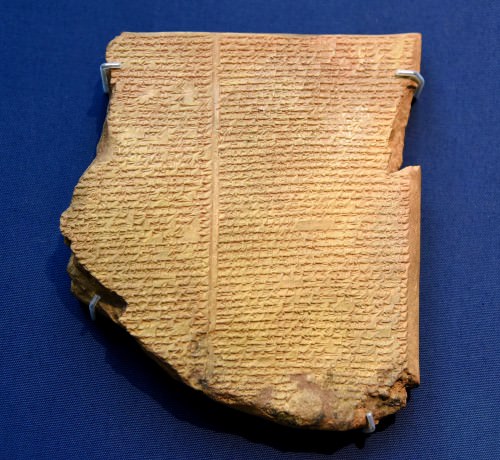
Flood Tablet of the Epic of Gilgamesh
Prior to the mid-19th century CE, the Bible was considered the oldest book in the world and the stories it contained were thought to be original pieces written by God or God-inspired. After archaeological digs in the region of the Fertile Crescent, however, and the discovery of the Sumerian civilization, it became clear that biblical narratives were derived from earlier Mesopotamian works. Mesopotamian religion and literature, in fact, would inspire and inform that of many other later cultures.
CHANGING EMPIRES
The region changed hands many times through the ages. By 912 BCE the Assyrians controlled the Fertile Crescent and developed their vast empire. The Neo-Assyrian Empire was ruled by some of the best-known kings from antiquity including Tiglath Pileser III (745-727 BCE), Sargon II (722-705 BCE), Sennacherib (705-681 BCE), Esarhaddon (681-669 BCE) and Ashurbanipal (668-627 BCE). Ashurbanipal prized knowledge highly and ordered all the literary works of the region copied and stored in his great library.
When the Neo-Assyrian Empire fell in 612 BCE, the invading forces set fire to the libraries of the cities but, since the works were written on clay tablets, they were only baked harder, not destroyed. The invaders, inadvertently, were responsible for the preservation of the very culture they sought to destroy.
By 580 BCE, the Neo-Babylonian Chaldean Empire under Nebuchadnezzar II (634-562 BCE) was in power and Babylon flourished as the greatest city on earth. Allegedly, at this time, Nebuchadnezzar had the famous Hanging Gardens of Babylon created for his wife to remind her of her homeland. In 539 BCE Babylon fell to Cyrus the Great (d. 530 BCE) after the Battleof Opis and the lands fell under the control of the Achaemenid Empire, also known as The First Persian Empire.
Alexander the Great invaded the area in 334 BCE and, after him, it was ruled by the Parthians, among others, until the coming of Rome in 116 CE. After the short-lived Roman annexation and occupation, the region was conquered by the Sassanid Persians (c. 226 CE) and, finally, by the Arabian Muslims in the 7th century CE.
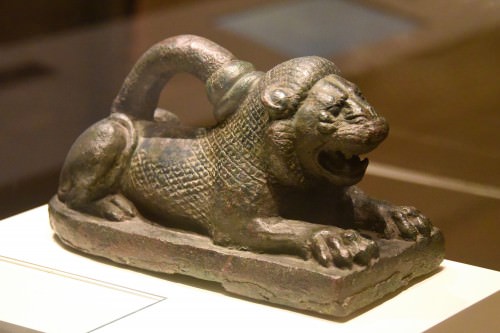
Achaemenid Lion Weight
By this time the glorious achievements of the early cities which grew up beside the Tigris and Euphrates Rivers had long been disseminated throughout the ancient world but the cities themselves were mostly in ruins through the destruction caused by the many military conquests in the region as well as natural causes such as earthquakes and fire. Rampant urbanization and the over-use of the land also resulted in the decline and eventual abandonment of the cities of the Fertile Crescent.
BABYLON'S NAME WOULD FOREVER BE LINKED TO SIN & CORRUPTION BY THE LATER HEBREW SCRIBES.
The city of Eridu, considered by the early Mesopotamians to be the first city on earth, built and inhabited by the gods, had been abandoned since 600 BCE, Uruk, the city of Gilgamesh, since 630 CE and Babylon, the city known for high culture, writing, law, science, and all manner of learning in the ancient world was a vacant ruin. Babylon's name would forever be linked to sin and corruption by the later Hebrew scribes who wrote the biblical narratives but, in its time, was greatly respected as a center of learning and civilization.
THE FERTILE CRESCENT TODAY
In 2001 CE the National Geographic News reported that the Fertile Crescent was rapidly becoming so only in name as, due to extensive damming of the rivers as well as a massive draining works program initiated in southern Iraq from the 1970's CE on, the fertile marshlands which once covered 15,000 – 20,000 square kilometers (5,800 – 7,700 square miles) had shrunk to a mere 1,500 – 2,000 square kilometers (580 – 770 square miles).
As pleas from environmental groups and regional farmers to stop damming and drainage projects were ignored by the governments of Iraq, Syria, and Turkey, the situation worsened so that, presently, the region which once was the lush paradise and cradle of civilization largely consists of dry, cracked plains of sun-baked clay.
Even after continued, long-term, threats to the environment were made clear to the governments of the region, no substantial efforts were made to preserve the land or reverse the damage. It has been observed by many scholars, historians, environmentalists, and writers through the centuries that human beings fail to learn from their pasts - whether individually or collectively. The philosopher George Santayana famously noted that "those who cannot remember the past are condemned to repeat it" and this paradigm rings as true for the Fertile Crescent as it does for any other region in the world today.
Hellenic World › Ancient History
Definition and Origins
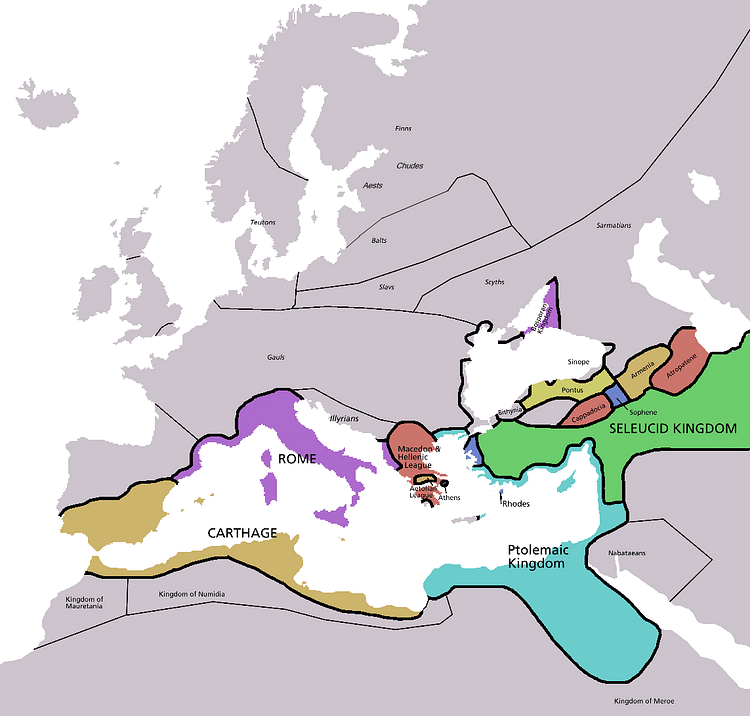
'The Hellenic World ' is a term which refers to that period of ancient Greek history between 507 BCE (the date of the first democracy in Athens ) and 323 BCE (the death of Alexander the Great ). This period is also referred to as the age of Classical Greece and should not be confused with The Hellenistic World which designates the period between the death of Alexander and Rome 's conquest of Greece (323 - 146 - 31 BCE). The Hellenic World of ancient Greece consisted of the Greek mainland, Crete, the islands of the Greek archipelago, and the coast of Asia Minor primarily (though mention is made of cities within the interior of Asia Minor and, of course, the colonies in southern Italy ). This is the time of the great Golden Age of Greece and, in the popular imagination, resonates as 'ancient Greece'.
The great law-giver, Solon, having served wisely as Archon of Athens for 22 years, retired from public life and saw the city, almost immediately, fall under the dictatorship of Peisistratus. Though a dictator, Peisistratus understood the wisdom of Solon, carried on his policies and, after his death, his son Hippias continued in this tradition (though still maintaining a dictatorship which favored the aristocracy). After the assassination of his younger brother (inspired, according to Thucydides, by a love affair gone wrong and not, as later thought, politically motivated), however, Hippias became wary of the people of Athens, instituted a rule of terror, and was finally overthrown by the army under Kleomenes I of Sparta and Cleisthenes of Athens.Cleisthenes reformed the constitution of Athens and established democracy in the city in 507 BCE. He also followed Solon's lead but instituted new laws which decreased the power of the artistocracy, increased the prestige of the common people, and attempted to join the separate tribes of the mountan, the plain, and the shore into one unified people under a new form of government. According to the historian Durant, "The Athenians themselves were exhilarated by this adventure into sovereignty. From that moment they knew the zest of freedom in action, speech, and thought; and from that moment they began to lead all Greece in literature and art, even in statesmanship and war " (126). This foundation of democracy, of a free state comprised of men who "owned the soil that they tilled and who ruled the state that governed them", stabilized Athens and provided the groundwork for the Golden Age.
THE GOLDEN AGE OF GREECE, ACCORDING TO THE POET SHELLEY, "IS UNDOUBTEDLY...THE MOST MEMORABLE IN THE HISTORY OF THE WORLD".
The list of thinkers, writers, doctors, artists, scientists, statesmen, and warriors of the Hellenic World comprises those who made some of the most important contributions to western civilization : The statesman Solon, the poets Pindar and Sappho, the playwrights Sophocles, Euripedes, Aeschylus and Aristophanes, the orator Lysias, the historians Herodotus and Thucydides, the philosophers Zeno of Elea, Protagoras of Abdera, Empedocles of Acragas, Heraclitus, Xenophanes, Socrates, Plato, and Aristotle, the writer and general Xenophon, the physician Hippocrates, the sculptor Phidias, the statesman Pericles, the generals Alcibiades and Themistocles, among many other notable names, all lived during this period. The Golden Age of Greece, according to the poet Shelley, "is undoubtedly...the most memorable in the history of the world" for the accomplishments and advancements made by the people of that time. Interestingly, Herodotus considered his own age as lacking in many ways and looked back to a more ancient past for a paradigm of a true greatness. The writer Hesiod, an 8th century BCE contemporary of Homer, claimed precisely the same thing about the age Herodotus looked back toward and called his own age "wicked, depraved and dissolute" and hoped the future would produce a better breed of man for Greece. Herodotus aside, however, it is generally understood that the Hellenic World was a time of incredible human achievement.
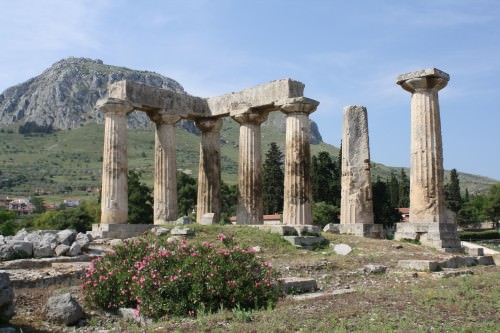
Monolithic Columns, Corinth
Major city-states (and sacred places of pilgrimage) in the Hellenic World were Argos, Athens, Eleusis, Corinth, Delphi, Ithaca, Olympia, Sparta, Thebes, Thrace, and, of course, Mount Olympus, the home of the gods. The gods played an important part in the lives of the people of the Hellenic World; so much so that one could face the death penalty for questioning - or even allegedly questioning - their existence, as in the case of Protagoras, Socrates, and Alcibiades (the Athenian statesman Critias, sometimes referred to as `the first atheist', only escaped being condemned because he was so powerful at the time). Great works of art and beautiful temples were created for the worship and praise of the various gods and goddesses of the Greeks, such as the Parthenon of Athens, dedicated to the goddess Athena Parthenos (Athena the Virgin) and the Temple of Zeus at Olympia (both works which Phidias contributed to and one, the Temple of Zeus, listed as an Ancient Wonder). The temple of Demeter at Eleusis was the site of the famous Eleusinian Mysteries, considered the most important rite in ancient Greece. In his works The Iliad and The Odyssey, immensely popular and influential in the Hellenic World, Homer depicted the gods and goddesses as being intimately involved in the lives of the people, and the deities were regularly consulted in domestic matters as well as affairs of state. The famous Oracle at Delphi was considered so important at the time that people from all over the known world would come to Greece to ask advice or favors from the god, and it was considered vital to consult with the supernatural forces before embarking on any military campaign.
Among the famous battles of the Hellenic World that the gods were consulted on were the Battle of Marathon (490 BCE) the Battles of Thermopylae and Salamis (480 BCE), Plataea (479 BCE,) and The Battle of Chaeronea (338 BCE) where the forces of the Macedonian King Philip II commanded, in part, by his son Alexander, defeated the Greek forces and unified the Greek city-states. After Philip's death, Alexander would go on to conquer the world of his day, becoming Alexander the Great.Through his campaigns he would bring Greek culture, language, and civilization to to the world and, after his death, would leave the legacy which came to be known as the Hellenistic World.
LICENSE:
Article based on information obtained from these sources:with permission from the Website Ancient History Encyclopedia
Content is available under License Creative Commons: Attribution-NonCommercial-ShareAlike 3.0 Unported. CC-BY-NC-SA License